On all the computers in Turlington 1341, the classroom. Click here for class schedule.
Work on pronunciation with visual feedback.
Note: the classroom computers have very high default sound settings. Open Sanako Media Player first, because it will automatically regulate the sound. Also, you can press Ctrl + Esc to access the Windows volume controls.
Best login: your gatorlink ID, which is uniquely connected with you.
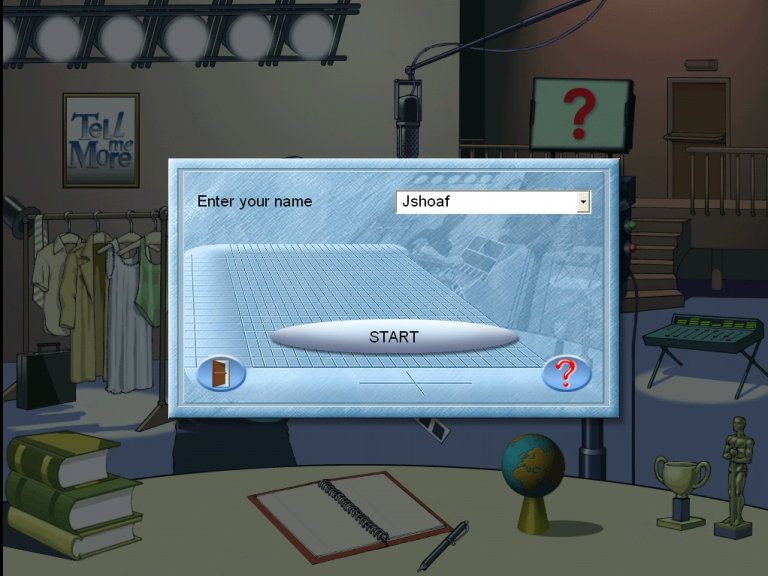
Login screen
Next

Every page has a menu running along the bottom which allows you to
go back one page,
go to the “Film Set,”
or choose a type of activity.
To change lessons, you have to return to the Film Set and click on the clothes rack.
Menus
Next
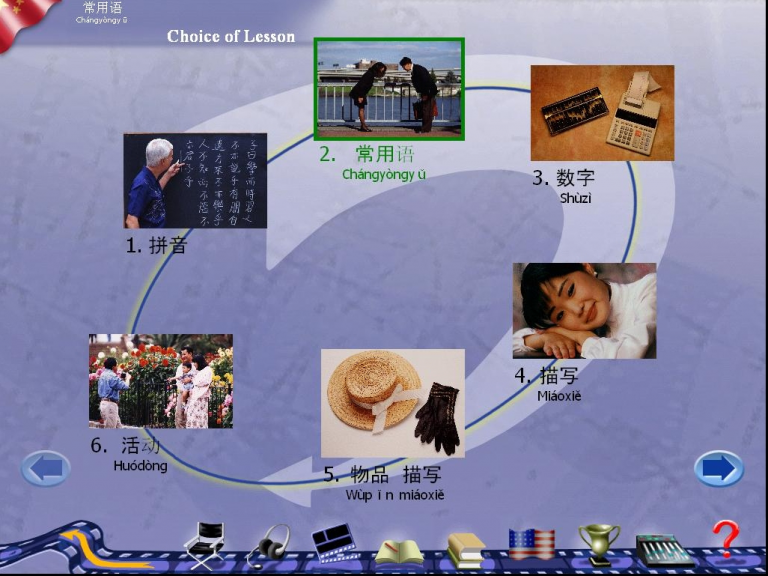
Choosing a Lesson
Next
You can change the difficulty level of the recognition by going to OPTIONS

and raising the level from 3 (normal) to 7 (hard). At 7, you have to try harder to match the model voices. Be sure that the “Speech recognition” option is checked; if it is not checked, the dialogues will not work or be scored properly.

NOTE: You can also use OPTIONS to specify what kind of text you want to see (no romanji at all, for example).
In these exercises, you will see an interface telling you to “Listen” and then to “Speak.” For the Dialogues, you listen to a question or comment to which you must respond. For Pronunciation, you listen to the model voice.


If the whole thing is going too fast for you, you can use OPTIONS to slow it down. You can also just use the Pause button to get your bearings.

Adjusting difficulty; interfaces for listening and speaking
Next
You can change to pinyin transcription, or to showing just the characters, in the “options” interface.

(click on Options and then the tab showing the clock and number 3)
When you are using the Dialogues, both characters and pinyin are shown, and you can access a translation, so you learn new characters.
When you are using the Pronunciation, the choice is between pinyin or characters. The pinyin includes tone marks, which may be helpful in targeting the pronunciation.

Pinyin and Characters
Next
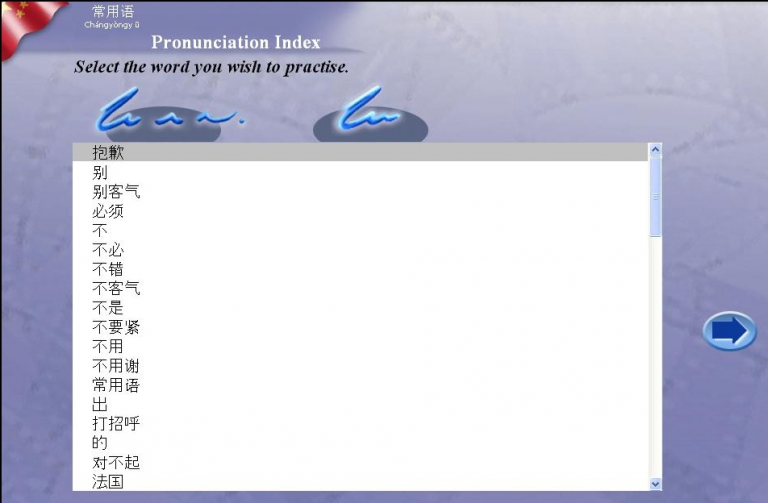
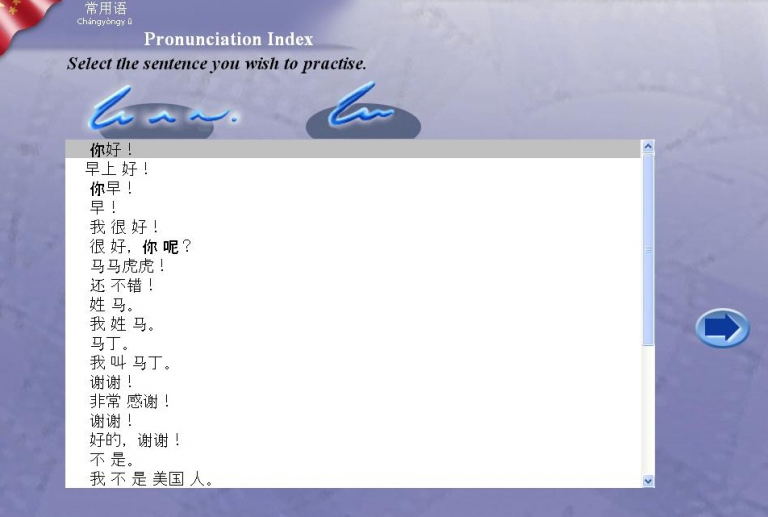
Next
Scores are recorded as blocks of purple (not good enough) and blue (acceptable). Words which are not acceptable appear in red.

Remember that you can change to pinyin transcription using the “options” interface. The pinyin includes tone marks so you should use that as a guide.
If you raise the difficulty level in OPTIONS, it will be harder to get to the blue. Below are attempts at a sentence. The upper image had a setting at Difficulty Level 3. The bottom one had Difficulty Level 7.


Pronunciation 2
Next
Of course there is not a single correct way to pronounce any language, and not all native speakers will produce the same patterns. But you can use the visual information to understand the syllable length and rising or falling tones which are appropriate for a particular word or phrase.

Don’t keep trying to practice until you can match the model exactly, but learn what to listen for in your own speech.
Pronunciation 3
Next
Don’t forget the pause button!
You can mouse over an unfamiliar word to get an English translation.
You can turn the Pinyin transcription feature off or on.
You can click on the loudspeaker next to a sentence to hear it spoken.
When you give a meaningful reply, sometimes you get a further comment!
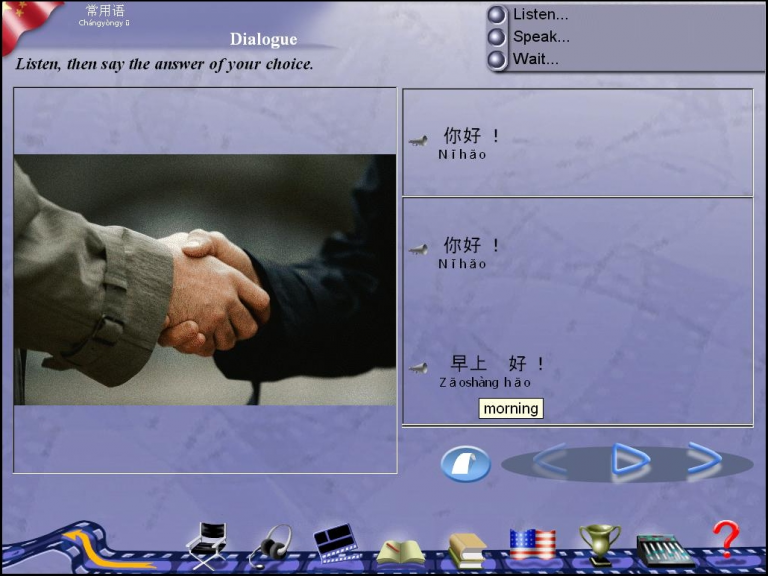
If there is no invitation to speak in the top right-hand corner, see Troubleshooting below.
Dialogues
Next
When you click on the exercises, you get a menu of different kinds of games to play. Do not click on the orange pennant. Instead of opening an exercise, it will kill the program and maybe the computer.
If one type of exercise is not available for this lesson, it will appear greyed-out.
You click the red checkmark to check how you are doing. You can click the lightbulb to get the answer.
Some of the exercises are more fun than others.
The Dictation and Crossword require typing in pinyin.

Exercises
Next
When you encounter an unfamiliar character, you can listen to the sounds or view the pinyin transcription, and then look it up in the glossary based on the initial sound of the word.
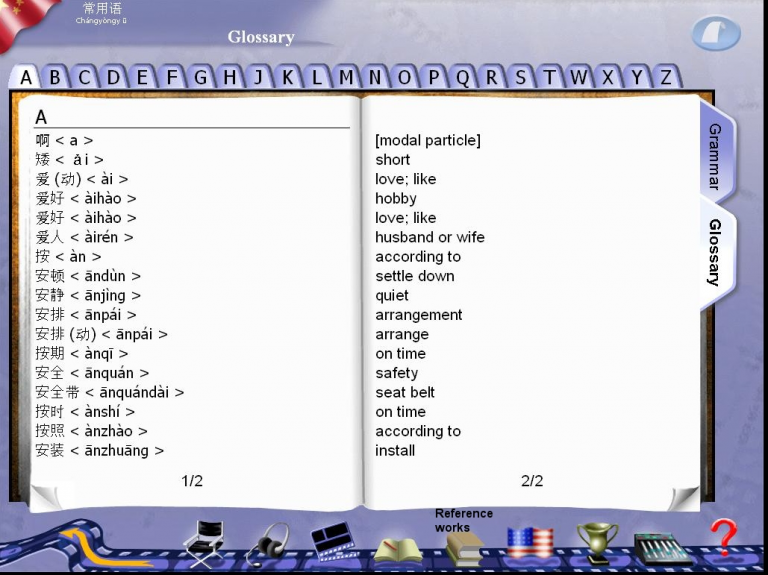
Reference Works
Next
Recording the practice should be done at the end of the session when you finish the work. This can be done in one of two ways:
(1) Ask a lab assistant to note down your scores.
(2) Press Print Screen. Press Ctrl + Esc. Using the Start menu, select Programs->Accessories->Paint. In the Paint interface, press Ctrl + V to paste the entire screen into the Paint program. Then save the image file into the appropriate folder on Crossroads. Or: save it on your desktop to email to your instructor. Name the file with your name or gatorlink userid and the lesson number (for example, jshoaf1.jpg). If you plan to email it, save it as a .jpg file in Paint; Paint’s default format, bitmap, produces extremely large files, not good for emailing.

If your DIALOGUE scores are not showing up, see Troubleshooting below.
Scoring
Next

INTERNAL ERROR #4 is an error message which prevents you from completing the exercises for a chapter. You can access the exercises in a different way. Click on the icon that takes you to to the dialogue interface:

Then click on the icon that looks like a strip of paper in a blue oval. The resulting menu will allow you to access the exercises while bypassing the error message.

If you are working on the DIALOGUES but there is no SPEAK feature, you are in “exploration” mode. You can click on an answer to the question, but you will not get credit
To activate the SPEAK feature, go to OPTIONS and check the “Speech regognition” feature at the top right.
